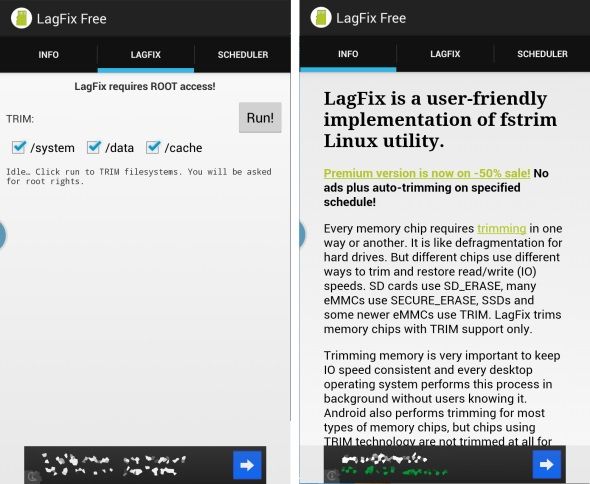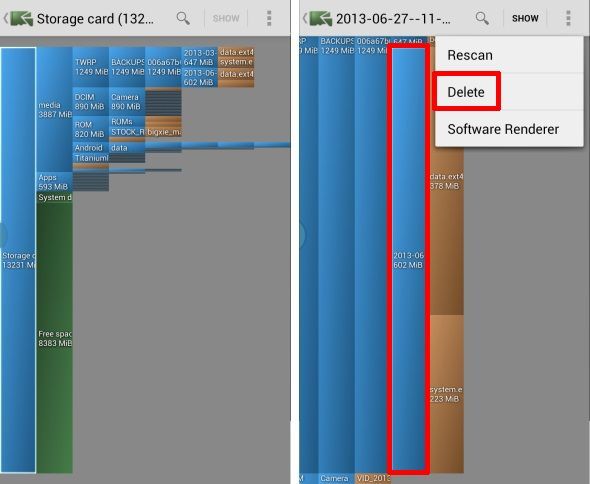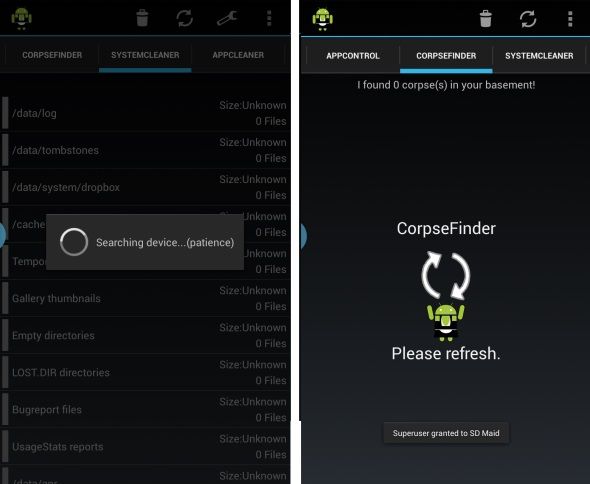Got a laggy Android device? There's a fix for you out there, but it requires root access. While the latest version of Android (4.3) solves this bug, for the majority of users who won't receive a firmware update, the free app LagFix could solve the problem.
It's no secret that Android lacks a lot of polish as an operating system. First, it doesn't maintain itself very well. Over time apps slow to crawl. That's because of a lack of TRIM implementation. The TRIM command, which Android failed to implement, allows solid state storage to maintain its original performance. Second, it also sucks at removing wasted space and empty folders. Third, when manufacturers use cheap memory it causes poor performance.
Fortunately, with the right device, all these problems can easily be fixed.
What is TRIM, Anyway?
We need to explain what TRIM is, before elaborating on how the LagFix app eliminates latency experienced on Android devices: Your solid state storage device doesn't actually erase files, even through you've uninstalled or removed them. This is a peculiarity native to solid state storage. Erased files are simply invisible to the operating system. TRIM command is a Linux executable that solves this issue by making erased files visible, and thus eraseable.
If the TRIM command is never run, these unerased blocks become a speed bottleneck resulting in horrible performance. Specifically, anything that uses a cache — such as the browser — will perform terribly.
In short, TRIM command in modern operating systems marks blocks of data for deletion. When data isn't deleted the operating system must find potions of its drive marked for deletion and then overwrite it. The extra overhead dramatically slows down write speeds. Without this feature, all drives suffer from stutter and slowdown.
Solid State Drives and newer eMMC modules on modern smartphones include compatibility with TRIM. Conversely, inexpensive flash memory modules on older smartphones and tablets lack this ability. The difference between flash memory and latter day eMMCs is moot, unfortunately, as operating system-based TRIM doesn't work in Android 4.2 and earlier versions.
LagFix [No Longer Available]
WARNING: LagFix has been known to "brick" (destroy) incompatible devices. Check your device's compatibility here [No Longer Available]. Also, you may want to Google your device + "LagFix".
LagFix performs a very simple function: On compatible, rooted devices it optimizes solid state storage by marking "erased" blocks for deletion – in the same manner as TRIM would. In a sense, it's a manual version of TRIM.
LagFix isn't completely problem-free. It won't work with older eMMC and flash storage drives. Also, some Samsung devices cannot use the app. In fact, LagFix's activation on select Samsung devices will render your gadget utterly useless – for unknown reasons. Its successful function depends on the specific chip inside your phone. Martin Brinkman's article turned me onto Exynos Mem Bug Checker [No Longer Available], which scans your Samsung device for the incompatible chips. So before attempting a manual TRIM, check the app first — otherwise, you may end up with a brick on your hands.
Again, keep in mind that LagFix requires root access.
Cache2SD and Multi-Browser2RAM
In addition to poor software design, cheap memory modules cause lag issues with many smartphones and tablets. Oftentimes the flash memory-based hard drives inside of top-tier tablets, like the Asus Transformer, suffer from horrendous write speeds. This results in slow, laggy performance. These issues can be resolved by moving the device's cache to a SD card. However, the SD itself is based on flash memory and cheap ones have terrible performance.
Anyone who wants to improve their device's speed needs to get the highest class of flash memory: Class 10. Its performance benefits will only show up on software using your device's cache, if the cache exists on the SD card.
The Cache2SD mod, to my knowledge, only works on the Asus Transformer series of tablet. It resolves the issue of cheap, slow memory modules by moving your device's cache to the SD card. However, on later devices using eMMC (MultiMediaCard) technology, this fix is unnecessary.
Another option uses the Browser2RAM script. While some browsers, such as Dolphin, can move their caches to the SD card, Browser2RAM moves the cache to a RAM disk. This provides much faster performance – RAM used as a disk is very fast.
These two modifications exist only on the Asus Transformer series of tablet. Although in theory they could be adapted to any poorly designed device.
Running Out of Storage Space?
One of the biggest problems in Android is that of storage. Apps do not cleanly uninstall, oftentimes leaving behind rather large zombie folders. Another problem is of extra large caches. Fortunately, third-party apps can kill these files, without much issue. Of the many awesome space-saving apps covered by Erez, my favorites are DiskUsage and SD Maid.
DiskUsage: DiskUsage visually displays the amount of space available in your Android device. It also includes pinch-to-zoom and other novel features. I use it to locate and then zap any large, unused files.
SD Maid: SD Maid provides a huge number of functions. Of these, its most useful is its ability to clear the system folder, its empty folder finder and its duplicate file finder (paid version only).
Conclusion
The current performance problems in Android originate from both Google and device manufacturers. First, there never was proper implementation of TRIM in Android until 4.3. Second, manufacturers used cheap flash memory modules, resulting in extreme amounts of lag on many devices. Solving these issues will work on only a narrow selection of devices, with only a narrow selection of apps.
Anyone else sick of Android's poor performance? Vent your frustrations in the comments.
Image Credits: Snail by xandert via MorgueFile




